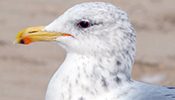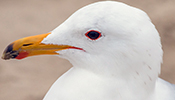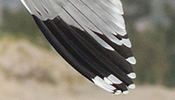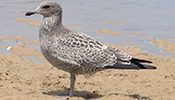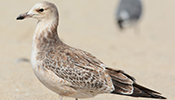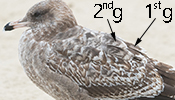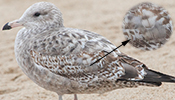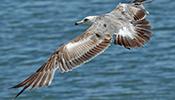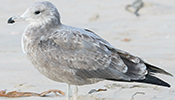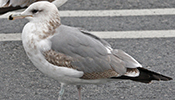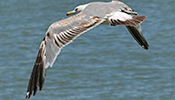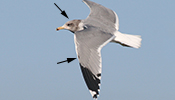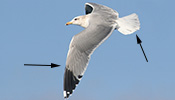|
||||||||||||
Coordinators:
1cy June 2cy Jan 3cy Jan 4cy / sub-ad Jan adult Jan |
|
|||||||||||
| previous page | PART 1. IDENTIFICATION SUMMARY & TAXONOMY |
| previous page | PART 2. FIELD IDENTIFICATION (adult & 1c) |
| previous page | PART 3. FIELD IDENTIFICATION (2c & 3c) |
| previous page | PART 4. RARER SPECIES & HABITAT / BEHAVIOR |
| below: | PART 5. DESCRIPTION AND MOLT |
DESCRIPTION AND MOLT
L c. californicus (breeds Great Basin and south).
Adult Cycle.
Complete PB molt (June/early July - mid-Sept./Oct.) produces adult basic plumage: head, neck, and underparts white; head, neck, and sometimes upper chest with variable (usually moderate to heavy) dusky streaking and mottling, often concentrated on hindneck. Upperparts medium gray (Kodak 6-7.5) with black wingtips (black on outer webs of P8/P9-P10, sometimes P7, extends to primary coverts); white scapular and tertial crescents; and white tips to outer primaries. Uppertail coverts and tail white. White trailing edge to secondaries (usually hidden at rest) and inner primaries breaks into discrete white tips on outer primaries; P5-P7 can have narrow white tongue-tips, P4 typically lacks black; P9-P10 (rarely just P10) have distinct white mirrors, which on P10 can merge into white tip. Underwings show blackish wingtips (with P9-P10 mirrors) cleanly demarcated from smoky gray white-tipped inner primaries and secondaries. Eyes dark brown (very rarely dull pale lemon (note: Howell pers. obs.)), orbital ring red (often dark gray in winter and pinkish in transition). Bill yellowish (sometimes pinkish to greenish basally through midwinter, and with orange-red gape from late winter) with orange-red gonydeal spot adjoining black subterminal band. Legs yellow to greenish yellow, often paler and more greenish during height of PB molt.
Partial PA molt (Sept.-Mar./Apr.) produces adult alternate plumage: head and neck clean white (usually by Mar); white primary tips can be lost through wear. By spring (and on some birds by mid-Jan.), orbital ring orange-red, legs brighter yellow to orange-yellow; bill bright yellow with orange-red gape, larger red gonydeal spot, and reduced subterminal black mark (black rarely lacking in midsummer(note: Howell pers. obs.)).
First Cycle.
Juvenile (July-Dec.): highly variable, but most birds fairly dark gray-brown overall. Head, neck, and underparts variably streaked and mottled whitish, becoming whitish on vent and undertail coverts, which are barred dark brown; many birds have forehead, lores, and chin bleached to creamy, and some have foreneck and underparts mostly creamy or dusky pale cinnamon. Upperparts with buff (bleaching to dull whitish) scaly and notched edgings, the outer greater coverts often with unmarked (or lightly marked) bases. Tertials blackish brown with notched whitish tips and distal edging, and usually a pale brown subterminal patch. Uppertail coverts whitish with strong dark brown barring. Flight feathers black to brownish black, narrowly tipped whitish, with inner primaries at most only slightly paler, not forming a distinct pale panel; whitish tips to outer primaries visible at rest (often lost through wear). Tail blackish to blackish brown with limited whitish barring on inner webs of outer rectrices (rarely visible except when spread) and whitish ribbing on outer web of R6; some birds have a subterminal band of small whitish marks creating a lace-tipped effect.
IN FLIGHT: brownish to gray-brown overall with contrasting blackish flight feathers and usually a plain dark band across bases of greater coverts; underwings gray-brown with inner primaries looking paler when backlit; tail coverts strongly barred. Eyes dark, bill starts out blackish but soon attains flesh basally, typically flesh pink with fairly clean-cut blackish tip by late fall (a few birds keep dark bill at least through Oct.); legs dusky flesh to flesh pink.
PA1 molt (Aug-Apr.May; often includes upperwing coverts, sometimes tertials) produces first alternate plumage: head, neck, chest, and flanks smoky gray-brown to sooty gray, often mixed with bleached juvenal feathers, and with variable whitish streaking and mottling; face and chest often bleach to whitish. A1 scapulars highly variable, ranging from dark brown with pale gray edging (early-molted feathers) to fairly plain medium gray (late-molted feathers); a common pattern of first-winter birds is a variegated, brown-and-gray back that features numerous anchor-patterned scapulars. By late winter, lesser coverts often bleach to a whitish carpal panel. Bill flesh pink basally with clean-cut black tip; legs flesh pink, often with a blue-gray hue to tibia by midwinter.
Second Cycle.
Complete PB2 molt (May/June - late Aug./Sept.) into second basic plumage. Head, neck, and underparts whitish with variable dusky brown streaking and mottling, tail coverts white with dark bars absent (or limited mainly to longest coverts). Upperparts variegated brown and gray, many birds with some plain gray back feathers; greater coverts and tertials dark brown overall with whitish distal speckling. Flight feathers blackish with a variably contrasting gray-brown to pale gray panel on inner 3-5 primaries, P10 sometimes with a small whitish mirror; outer rectrices more extensively white basally, with bases speckled and marbled white (sometimes with one or more white or mostly white feathers by late winter, perhaps attained by PA2 molt). Wing-linings whitish with brown mottling to mostly brownish. Eyes dark brown, bill flesh pink to bluish flesh with black distal third and a fine pale tip, legs flesh pink to bluish flesh.
Partial PA2 molt (Sept. - Apr.; often includes some upperwing coverts, possibly one or more rectrices) produces second alternate plumage: head, neck, and underparts white, variably streaked and mottled dusky (often bleaching and wearing to mostly white by summer), back becomes mostly plain gray, and many birds attain some gray upperwing coverts, especially median coverts. Orbital ring brightens to orange or pinkish red in summer. Bill often fleshy blue-green by winter, with broad black distal band and small pale tip, sometimes a blush of orange at gonys; by midsummer bill often brightens to yellow with a reddish gonydeal spot and black distal marks. Legs flesh to bluish flesh, sometimes becoming yellowish flesh in summer.
Third Cycle.
Complete PB3 molt (late May/June - Sept./Oct.) produces third basic plumage. Overall resembles adult basic but averages more dusky streaking and mottling on head, neck, and chest; wingtips average smaller white tips; some upperwing coverts often washed brownish; tertials can have dark brown centers. Tail often has black distal marks (varies from all white to having a subterminal black band). Wingtip pattern averages more black and less white than adult, with variable blackish on primary coverts and alula; P9-P10 mirrors smaller. Underwings often have some dusky mottling on coverts. Eyes dark brown (rarely pale dusky lemon); bill pale greenish to gray-green with broad black subterminal band, often some orange-red at gonys, and sometimes tinged pinkish basally; legs pale gray-green, sometimes tinged flesh.
Partial PA3 molt (Sept.-Mar./Apr.) into third alternate plumage: dark markings on head and neck reduced to absent; white tips to outer primaries can be lost by wear. Bill and legs brighten in late winter, often indistinguishable from adult by summer. Adult plumage attained by complete PB4 molt (June-Sept./Oct.) but some presumed fourth-cycle birds retain signs of immaturity on alula, primary coverts, and tail.
L. C. albertaensis (breeds n. Great Plains).
Very similar to nominate californicus; many birds probably not safely identified to subspecies in the field. Averages 5-12 percent larger than californicus in linear dimensions (especially bill length and depth) and 27 percent greater in body mass(note: Jehl 1987); adult averages paler gray on upperparts (Kodak 5-6 versus 6-7.5 in californicus).
In describing the subspecies albertaensis, Jehl (note: Jehl 1987) noted more-extensive pale gray tongues on the outer primaries, which King (note: King 2000) attempted to expand upon: on average, albertaensis has longer basal gray tongues on P7-P10 than does californicus, creating a relatively less extensive black wingtip (black on outer web of P7-P8 often does not reach primary coverts). Other average differences include larger white P9-P10 mirrors on albertaensis, which may more often show a solid white tip to P10, and a greater tendency in albertaensis to have narrow white tongue-tips on P5-P7. However, given individual variation and overlap in characters(note: King 2000), field identification of lone birds based simply on wingtip pattern is inadvisable. Identification of albertaensis is best based on its bulkier dimensions, bigger bill, and paler upperparts (often noticeable in direct comparison with californicus, but difficult to appreciate on sunny days); wingtip pattern is a supporting feature. No plumage differences known in first-cycle birds (note: Jehl 1987), upperpart tone may be helpful for second- and third-cycle birds (with albertaensis being slightly paler) but confirmation desirable from birds of known natal origin.
HYBRIDS
With American Herring Gull in Colo. (note: Chase 1984); possibly with Ring-billed Gull (note: Dunn and Howell pers. obs. - photos 23.26-23.28 in The Peterson Reference Guides).
 California Gull californicus adult, May 21 2018, Pismo beach, CA, USA. Picture: Alex Abela.
California Gull californicus adult, May 21 2018, Pismo beach, CA, USA. Picture: Alex Abela. California Gull californicus adult, May 05 2019, Pismo beach, CA, USA. Picture: Alex Abela.
California Gull californicus adult, May 05 2019, Pismo beach, CA, USA. Picture: Alex Abela. California Gull californicus adult, May 11 2018, San Luis Obispo, CA, USA. Picture: Alex Abela.
California Gull californicus adult, May 11 2018, San Luis Obispo, CA, USA. Picture: Alex Abela. California Gull californicus adult, May 21 2018, Pismo beach, CA, USA. Picture: Alex Abela.
California Gull californicus adult, May 21 2018, Pismo beach, CA, USA. Picture: Alex Abela.
 California Gull californicus
California Gull californicus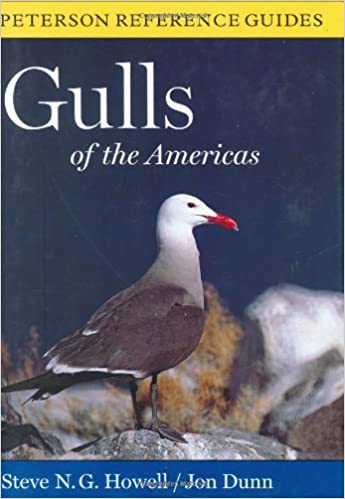 adult: May
adult: May
